【編】Douglas Dean Johnson: 1945-08, NM: Padilla が UFO からもぎ取った金属破片の正体(途中1)
前置き
【以下の記事は編集途上】
Douglas Dean Johnson による
Crash Story File: The “Alien” Artifact with Metric Dimensions
の和訳を記録しておく。出典元サイトの消滅に備えてソース記事も丸ごと引用しておく。
出典
Crash Story File: The “Alien” Artifact with Metric Dimensions https://douglasjohnson.ghost.io/crash-story-file-the-alien-artifact-with-metric-dimensions/
関連
❏ Douglas Dean Johnson : 1945-08 の UFO 墜落事件は全くの捏造、Jacques Vallee は二人の証言者の捏造話に騙された (2024-06-11)
Douglas Dean Johnson:Ray Stanford の UFO 映像も過去の証言も問題が多い (2024-07-12)
SMiles Lewis が Douglas Dean Johnson に嘲笑的に言及 (2024-07-14)
Jeremy Vaeni:Jacques Vallee の「1945年 Trinity UFO 墜落」の主張を批判 (2024-07-07)
Douglas Dean Johnson: Ray Stanford が撮影した「Faraday rings を伴う UFO 画像」には多くの疑問がある (2024-07-13)
Douglas Dean Johnson:「Einstein-Oppenheimer 文書」が偽造である根拠 (2024-07-12)
和訳
途中
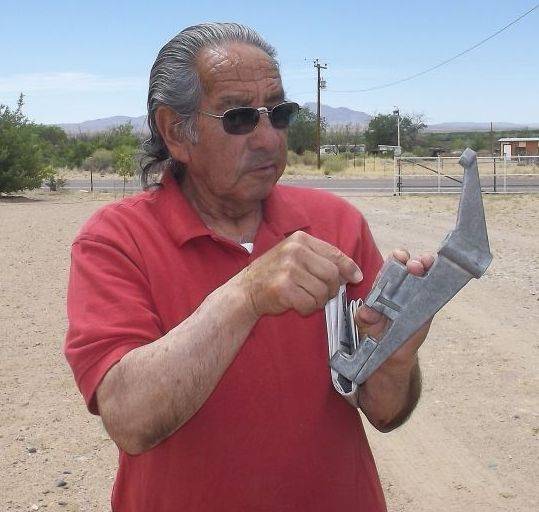
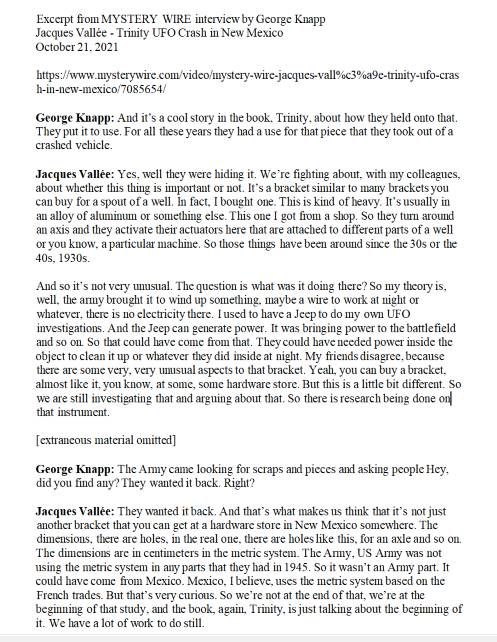
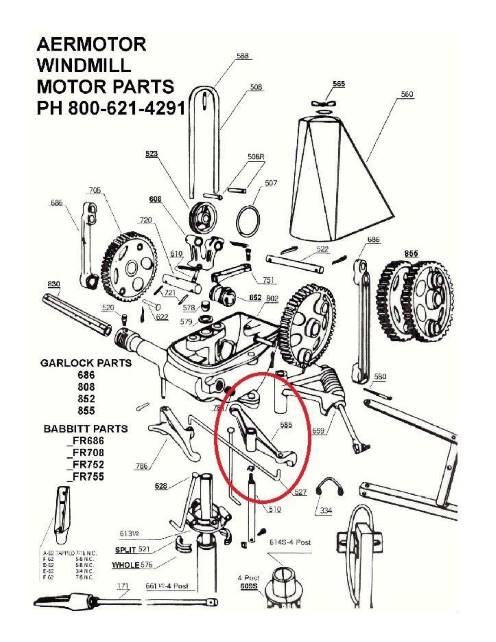
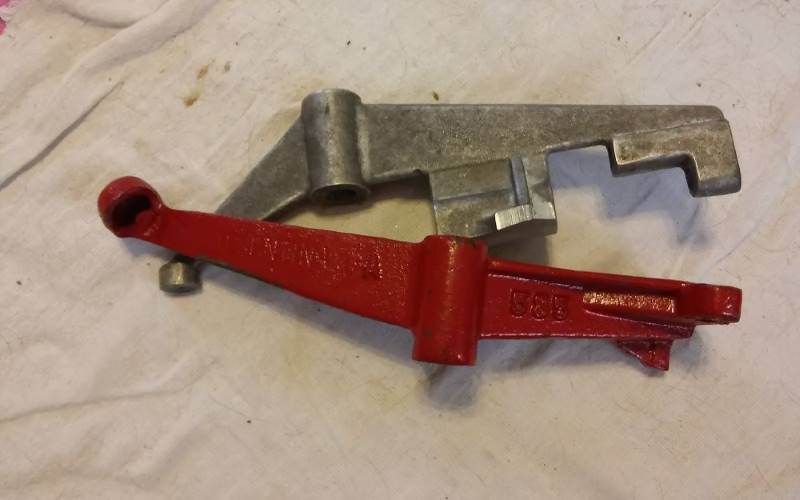
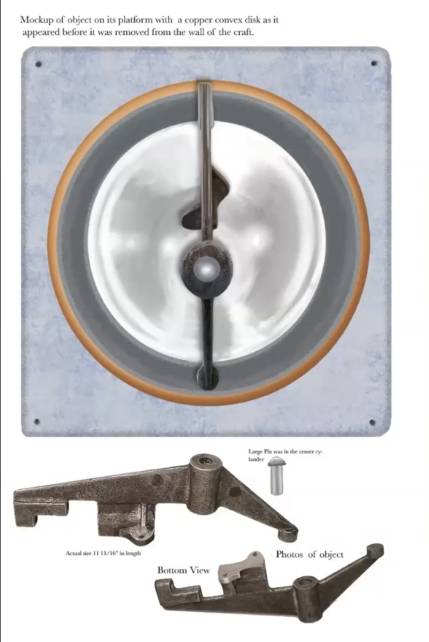
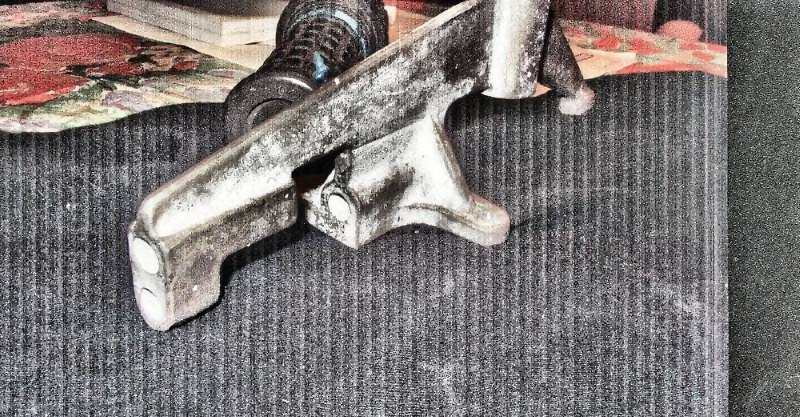
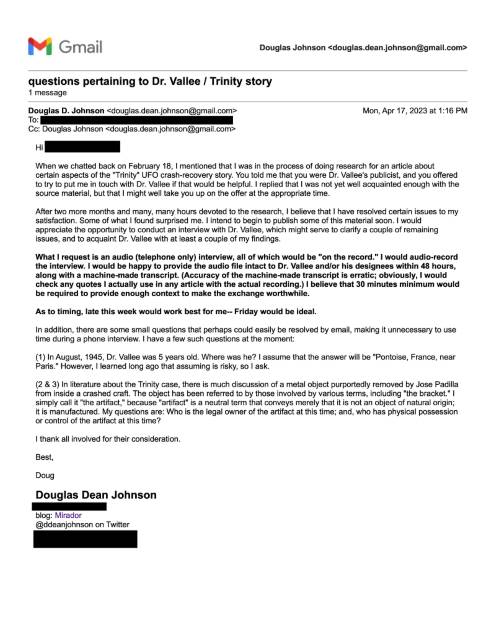
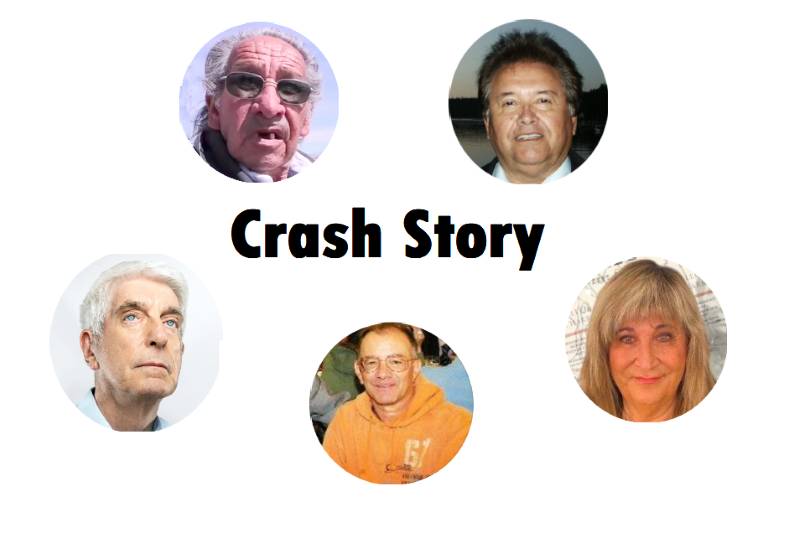
▼原文 展開
Crash Story File: The “Alien” Artifact with Metric Dimensions
DOUGLAS DEAN JOHNSON 17–21 minutes
May 1, 2023 • 12 min read
pic1
Joseph Lopez (Jose) Padilla with the artifact that he claims he pried off the inner wall panel of a crashed alien craft in August, 1945, when he was 8 years old. Photo circa 2014. By Douglas Dean Johnson
@ddeanjohnson on Twitter
Original publication: May 1, 2023. A log of subsequent updates appears at the end of the article. The most recent update was on August 22, 2024.
You are in the Crash Story Files, a series of investigative reports examining claims that a UFO crashed and was recovered near San Antonio, New Mexico, in August 1945. To go back to the Crash Story hub story and index, click here. For the most recent article summarizing the implosion of the Trinity UFO-crash hoax, click here.
“There seems to be nothing unusual about the metal which presents us with a problem.” – Paola Harris, MUFON UFO Journal, June 2016 (p. 12).
“What kind of interplanetary spacecraft would contain a device made of a common, human industrial alloy, without brand identification, manufactured to precise metric dimensions (30 cm long by 9 cm high) and metric diameters for all the holes? – Jacques Vallee, Trinity: The Best-Kept Secret (Second Edition, August 2022, page 306).
Beginning with early versions of the Reme Baca-Jose Padilla story, Padilla, while inside the crashed alien craft, uses “a pipe," or in later renditions a “cheat bar” (crowbar), to pry a metal device off the inner wall of the craft. As Padilla described it to radio host Richard Syrett in December 2010:
There was a piece of material there, you could turn it around in circles...I got a cheater bar, and I went back in there and pried it off, I ripped it right off...to me it looked like a boomerang.
“I had to put all my one hundred pounds that I weighed to get it off,” Padilla said in 2010 (Veritas interview at 30:10). Striving to explain the workings of his ostensibly eight-year-old mind, Padilla added, “I had to get something out of evidence, that will some day, you know, we’ll come up with something, you know.” (Veritas at 30:30)
I will refer to this metal object as “the artifact,” which is a neutral term that merely means it is an object that was manufactured by someone, not a product of natural processes. Both Vallee and Harris have referred to it as a “bracket.”
Jacques Vallee believes that the artifact is of terrestrial origin. In an October 21, 2021 interview with ufological promoter George Knapp, Jacques Vallee said, “It’s a bracket similar to many brackets can buy for a spout of a well. In fact, I bought one...so it’s not very unusual.” Vallee also observed that the object had dimensions “in the metric system,” and speculated that it might have been manufactured in Mexico rather than the United States.
pic
Excerpt from MYSTERY WIRE interview by George Knapp Jacques Vallée - Trinity UFO Crash in New Mexico October 21, 2021
https://www.mysterywire.com/video/mystery-wire-jacques-vall%c3%a9e-trinity-ufo-cras h-in-new-mexico/7085654/
George Knapp: And it's a cool story in the book, Trinity, about how they held onto that. They put it to use. For all these years they had a use for that piece that they took out of a crashed vehicle.
Jacques Vallee: Yes, well they were hiding it. We're fighting about, with my colleagues, about whether this thing is important or not. It's a bracket similar to many brackets you can buy for a spout of a well. In fact, I bought one. This is kind of heavy. It's usually in an alloy of aluminum or something else. This one I got from a shop. So they turn around an axis and they activate their actuators here that are attached to different parts of a well or you know, a particular machine. So those things have been around since the 30s or the 40s, 1930s.
And so it's not very unusual. The question is what was it doing there? So my theory is, well, the army brought it to wind up something, maybe a wire to work at night or whatever, there is no electricity there. I used to have a Jeep to do my own UFO investigations. And the Jeep can generate power. It was bringing power to the battlefield and so on. So that could have come from that. They could have needed power inside the object to clean it up or whatever they did inside at night. My friends disagree, because there are some very, very unusual aspects to that bracket. Yeah, you can buy a bracket, almost like it, you know, at some, some hardware store. But this is a little bit different. So we are still investigating that and arguing about that. So there is research being done on| that instrument.
[extraneous material omitted]
George Knapp: The Army came looking for scraps and pieces and asking people Hey, did you find any? They wanted it back. Right?
Jacques Vallee: They wanted it back. And that's what makes us think that it's not just another bracket that you can get at a hardware store in New Mexico somewhere. The dimensions, there are holes, in the real one, there are holes like this, for an axle and so on. The dimensions are in centimeters in the metric system. The Army, US Army was not using the metric system in any parts that they had in 1945. So it wasn't an Army part. It could have come from Mexico. Mexico, I believe, uses the metric system based on the French trades. But that's very curious. So we're not at the end of that, we're at the beginning of that study, and the book, again, Trinity, is just talking about the beginning of it. We have a lot of work to do still.
Likewise, in Trinity: The Best-Kept Secret (Second Edition), pages 139-140, Vallee wrote:
The shape and possible function are generally reminiscent of devices activating mobile vanes, such as the mechanism of water wells, and the mast section of windmills, for example in the Aermotor Company’s list of standard parts widely used in industry. Yet they don’t correspond to any of the specific products we’ve found so far.
pic
pic
Top: The Padilla-obtained artifact. Bottom: a similar artifact still available commercially and used for a variety of agricultural applications.
If Jose Padilla’s story had been that he found the artifact on the ground near the crashed spaceship, believers in the tale could simply say, “Well, obviously Jose jumped to the wrong conclusion—it was just an old piece of junk that happened to be sitting near where the alien spaceship crashed.” But Padilla swears that the artifact was securely pinned to a panel of the interior wall of the alien craft—so well secured that Padilla needed a crowbar and his full strength to pry it off.
Faced with objective physical findings incompatible with an unverified tale of purported events 75 years earlier, one might think that an analyst with a modicum of critical discernment would conclude, “Well, it looks like that old rascal Jose Padilla has been stringing us along.” But regrettably, that has not been Jacques Vallee’s conclusion, as is demonstrated by these passages from the Second Edition of Trinity: The Best-Kept Secret.
I had become convinced it was likely a common industrial object, but Paola disagreed, and indeed some mystery remained. Actually, it had only become more puzzling: How did that piece of rough aluminum alloy end up pinned to the interior wall of the extraordinary vehicle the military had been so eager to remove and hide away in an undisclosed laboratory, where it presumably rests today?” (Trinity, page 125)
That convoluted instrument may appear standard but it is not “unremarkable." We have yet to ask what an ordinary, human fragment of some low-tech aluminum gadget was doing aboard a fantastic craft dropping from the sky in the middle of a storm, shattering the Marconi Tower of the White Sands Missile Range as its crew of diminutive insectoids skidded weirdly through the cabin. (Trinity, page 140)
What kind of interplanetary spacecraft would contain a device made of a common, human industrial alloy, without brand identification, manufactured to precise metric dimensions (30 cm long by 9 centimeters high) and metric diameters for all the holes? (Trinity, page 306)
As for Paola Harris, she has continued to defend the position that the bracket itself is of non-human origin and was an integral part of the alien craft. During a virtual "master class" presentation on September 16, 2023, Harris said, "Jose went inside the craft, took a cheater bar or what do you call it, a crowbar, pulled the piece off. They will never mention... that it was on a plaque that looked like this, that it had a silver circle and a copper circle, and it revolved, it revolved. I wanted this to be the cover of our book, because if you just talk about the piece, [some people say] 'oh, it's an Army piece, they used it to wrap a cable.' No, no, no, no, no. If they did, why in the world did they put it up against a plaque like that?" [At 43:00 minutes. The illustration that Harris displayed during this part of her presentation appears just below.]
pic
Illustration of the manner in which the artifact was supposedly mounted on the inner wall panel of the alien craft. From internet presentation by Paola Harris, September 16, 2023. (Fair Use for purposes of commentary, criticism, scientific research, and investigative journalism.)
REME BACA’S TAKE
Reme Baca had his own explanation for the prosaic appearance of the artifact, in an interview with Ben Moffett of the Mountain Mail in 2003:
It was a fairly crude craft with no parts numbers on it, and the piece we have, we were told is not remarkably machined even for 1945. But there’s nothing that says aliens have to travel in remarkable spaceships.... Perhaps they got here by some method we can’t fathom and they manufactured a crude object here to get around in this atmosphere.
If that explanation seemed strained, is it any more so than this baffling, nonsensical suggestion found in Trinity: The Best-Kept Secret (Second Edition)?
The Marconi tower, which appears to have dominated the northern section of the White Sands Missile Range, reportedly generated its own power with a small windmill, so perhaps the specially-designed aluminum bracket came from there. [In some renditions of the Baca-Padilla story, the UFO struck this radio or radar tower before the craft slammed into the ground.] That would explain why the device was still inside the craft on the last day, unlike other materials the Army may have found there. This is only one of several hypotheses we entertain, but it would also account for the fact that the military desperately wanted to get it back... (Trinity, page 141)
Vallee and Harris did not explain how an alien craft striking a tower that had a small windmill on the top, would result in the windmill part becoming affixed with fasteners to the inner wall panel of the alien craft.
ONE ALUMINUM BRACKET IN TWO STARRING ROLES
In May 2023, I learned the Reme Baca, working in concert with Jose Padilla, had in 2002 tried to peddle the story of a UFO crash that occurred in 1946 (not 1945). One of the people he made the pitch to, UFO writer Tom Carey, tape recorded the conversation. Carey kindly dug out the tape and lent it to me.
The hoaxers presented the 1946-crash story as an authentic childhood memory, just as they did with the later version. However, other than the identities of the protagonists, this original version of the story differed in every significant aspect from the later tale that Vallee adopted. In the original version, the boys were going to a different place, in a different year, by a different mode of transportation, for a different reason, and encountered a different type of crashed alien craft, after which different people did different things, compared to the later version. However, Baca used what appears to be exactly the same aluminum bracket as a prop in both tales– although in the 1946-crash story, the alien artifact was obtained in a very different way than in the 1945-crash story.
I wrote this all up in detail in Crash Story File: The Reme Baca Smoking-Gun Interview (May 20, 2023). Months later, Jacques Vallee conceded that the Baca story of a 1946 UFO crash was "fiction"– yet Vallee continued to cling to the later rewrite.
pic
Reme Baca mailed this image to UFO writer Tom Carey in late 2002, representing it as a photo of an artifact the boys swiped off the back of a military "trailer" filled with debris from UFO that crashed in 1946. Carey scanned the image and retained it on a thumb drive. It appears to be the same object that Baca and Padilla later incorporated into their 1945 crash story, but with a different account of how they procured it.
THE FATE OF THE ARTIFACT
[UPDATE (September 30, 2023): In an internet "master class" on September 16, 2023, Paola Harris said, "Reme Bacca was pretty greedy. He wanted $250,000 for the piece [the artifact], and he wanted $250,000 for the story."]
In 2014, the year after Baca's death, Mexican ufologist Jaime Maussen visited San Antonio. There exists a video clip of Maussen, holding the artifact and remarking, "This is very important. You took this from a UFO. I think it is very valuable," and then asking Padilla what he intended to do with it. Padilla responded that he thought he would place it with a museum. Maussen asked, "Reme wanted a lot of money to present this [artifact], but you don't -- why?" Padilla answered, "Money is not important to me. It's just the principle."
動画
Mexican ufologist Jaime Maussen speaks with Jose Padilla about the artifact, 2014.
Who owns the artifact now? I asked Jacques Vallee this in an email dated April 17, 2023, but in his reply to my email, he did not answer that question.
pic
M Gmail
Douglas Johnson douglas.dean.johnson@gmail.com
questions pertaining to Dr. Vallee / Trinity story
Mon, Apr 17, 2023 at 1:16 PM
1 message
Douglas D. Johnson douglas.dean.johnson@gmail.com To: Cc: Douglas Johnson douglas.dean.johnson@gmail.com
Hi
When we chatted back on February 18, I mentioned that I was in the process of doing research for an article about certain aspects of the "Trinity" UFO crash-recovery story. You told me that you were Dr. Vallee's publicist, and you offered to try to put me in touch with Dr. Vallee if that would be helpful. I replied that I was not yet well acquainted enough with the source material, but that I might well take you up on the offer at the appropriate time.
After two more months and many, many hours devoted to the research, I believe that I have resolved certain issues to my satisfaction. Some of what I found surprised me. I intend to begin to publish some of this material soon. I would appreciate the opportunity to conduct an interview with Dr. Vallee, which might serve to clarify a couple of remaining issues, and to acquaint Dr. Vallee with at least a couple of my findings.
What I request is an audio (telephone only) interview, all of which would be "on the record." I would audio-record the interview. I would be happy to provide the audio file intact to Dr. Vallee and/or his designees within 48 hours, along with a machine-made transcript. (Accuracy of the machine-made transcript is erratic; obviously, I would check any quotes I actually use in any article with the actual recording.) I believe that 30 minutes minimum would be required to provide enough context to make the exchange worthwhile.
As to timing, late this week would work best for me -- Friday would be ideal.
In addition, there are some small questions that perhaps could easily be resolved by email, making it unnecessary to use time during a phone interview. I have a few such questions at the moment:
(1) In August, 1945, Dr. Vallee was 5 years old. Where was he? I assume that the answer will be "Pontoise, France, near Paris." However, I learned long ago that assuming is risky, so I ask.
(2 & 3) In literature about the Trinity case, there is much discussion of a metal object purportedly removed by Jose Padilla from inside a crashed craft. The object has been referred to by those involved by various terms, including "the bracket." I simply call it "the artifact," because "artifact" is a neutral term that conveys merely that it is not an object of natural origin; it is manufactured. My questions are: Who is the legal owner of the artifact at this time; and, who has physical possession or control of the artifact at this time?
I thank all involved for their consideration.
Best,
Doug
Douglas Dean Johnson
blog: Mirador @ddeanjohnson on Twitter
Dear Mr. Johnson:
April 17, 2023
As you may know from our book, our team's investigation of the Trinity case is an ongoing process: we are about to return to the site and related areas for expanded investigations next month, and we have new lab analyses under review, that may shed light on the case when this phase is completed and eventually published.
Given these plans, we welcome the research and advice of other serious researchers, and will take their findings into account in future phases, with credit given. I look forward to your contribution, since some of the technical and historical questions are still unresolved.
You are correct in your assumption that I lived in Pontoise with my parents around the time of the combats for the Liberation of France, which I witnessed.
Looking forward to our continued correspondence,
Jacques
Best,
In Trinity: The Best-Kept Secret (Second Edition, p. 315), the authors wrote, “[Jose Padilla] entrusted us with the unique object he retrieved from inside the craft, which we had the opportunity to analyze. It has now been donated to a University as part of our records of the case, according to his wishes.”
[UPDATE (September 30, 2023): In a "master class" presented on the internet on September 16, 2023 (ticket price $30), Paola Harris said that she had attempted to donate the artifact to Rice University, but "they didn't have a safe deposit box and they had no security, and they did not want it." So, she said, "the piece is now in Mexico City, and it will be at the University of Mexico City...they can analyze it, they can keep it. And I don't care if I receive it again, because for me, it's not about the piece." Ms. Harris also spoke about various disputed issues regarding the artifact. Under Fair Use, for purposes of commentary, scientific research, journalism, and education, I have embedded below a 7-minute excerpt from Ms. Harris's 99-minute presentation.]
動画
Paola Harris discusses the purported origins and attributes of the artifact, disputes about the artifact, and the current location of the artifact (the University of Mexico City), during 99-minute September 16, 2023 internet "master class." (Seven-minute excerpt about the artifact presented under Fair Use for purposes of scientific research, investigative journalism, commentary, and education.)
THE LABORATORY ANALYSES
From the earliest days of the Trinity story, Reme Baca referred to purported laboratory analyses, by persons he would not name, that supposedly showed the metal of the artifact to possess unusual properties. Electronic microscope photos showed hair-like structures, he said; for a number of years, Paola Harris suggested that these were micro-circuits. We need not spend any time on these anonymous studies (one of which was apparently performed by Baca’s brother in law).
In material submitted to Ryan S. Wood for a conference in 2005, Baca claimed that metal would not melt even when heated to 2000 degrees. Most aluminum alloys would melt at temperatures less than 1240 degrees Fahrenheit.
In June 2004, Baca gave a small piece of the artifact to visiting UFO author Timothy Good. In his 2007 book Need to Know, Good wrote:
It appears decidedly terrestrial, a point conceded by the witnesses. Looking like a bracket of some kind, it is 12 inches long, weighs 15 ounces and contains a number of holes for fasteners of some kind. A section cut off for analysis, as well as acid tests reveal the metal to be 200-series aluminum.
In Trinity: The Best-Kept Secret (Second Edition), Vallee wrote that by the time he got involved in studying the case:
It had already been tested in Mexico (on October 24, 2017) at the Centro Educational Analitico where chemical engineer Bernabe Hernandez Santos found a preponderance of Aluminum (757 mg per gram) followed by an “unreadable” element for 34.6 mg, then zinc (27.0), iron (6.5) and another unknown for 158.5 mg. All of which didn’t quite add up. “I don’t believe in unreadable elements,” I told Paola. “There must be better results somewhere and anyway, we’ll redo the measurements.” (Trinity, 65)
The results of an analysis conducted in Australia in 2016 are also summarized in Trinity (p. 139), and they were also unremarkable: "The sample is observed to be standard and unremarkable."
By 2015, Paola Harris had enlisted the aid of Jan Harzan, at that time the executive director of the Mutual UFO Network (MUFON). Harzan became a big promoter of the case, which was the subject of a feature article by Harris in the June 2016 edition of the MUFON UFO Journal, cited elsewhere in these Crash Story Files.
Harzan commissioned a new analysis by P.A. Budinger, “analytical scientist” at Frontier Analysis, Ltd. in Chagrin Falls, Ohio. The report can be viewed at the link below.
The Budinger report concluded that the metal samples “are aluminum primarily alloyed to copper and silicon...This composition is known and compares with cast aluminum in the 3XX.X series...and the 2XX.X series...These alloys have a wide variety of uses. Some include: engine crankcases, gas and oil tanks, engine oil pans, typewriter frames, and engine parts. Isotopic ratios determined for nickel, copper and zinc compare to terrestrial values.”
However, perhaps wary of disappointing the client, Budinger added that even though “the isotopic radios are terrestrial, an extraterrestrial source for the metals is not ruled out...The aliens may be time travelers...The aliens may have bases on Earth and construct their craft from materials found on Earth...”
One would think that all these analyses already performed would more than suffice. But, we read on page 65 of Trinity, “Jose recently gave the piece [the artifact] to Paola, who cut off a small section for me to have analyzed.” In an email to me dated April 17, 2023, Vallee said, "We have new lab analyses under review."
I can hardly wait for the lab reports.
pic
Clockwise from 1 o'clock: Remigio (Reme) Baca, Paola Harris, William P. "Billy" Brophy, Jacques Vallee, Joseph Lopez (Jose) Padilla. To return to the Crash Story hub story, click here.
REVISIONS TO THIS ARTICLE SINCE ITS INITIAL PUBLICATION ON MAY 1, 2023
(1) September 30, 2023: I inserted a two short updates, one still image, and one video clip from a presentation on the internet by Paola Harris on September 16, 2023, in which she discussed various disputed issues regarding the artifact, and said that it currently resides at "the University of Mexico City." Ms. Harris also revealed that Reme Baca had been "pretty greedy" and made unsuccessful attempts to sell the artifact for $250,000.
(2) December 29, 2023: I inserted a quotation from Paola Harris, from her September 16, 2023 virtual "master class," in which she described details of the "plaque" that the bracket was supposedly mounted on within the alien craft, as depicted in the illustration she displayed, in order to make her point that the bracket was an original part of the craft and not something that the Army added after the crash.
(3) August 22, 2024: I added the subsection headed "One Aluminum Bracket in Two Starring Roles," noting that Reme Baca had used what appears to be exactly the same aluminum object as a prop in a tale about a 1946 UFO crash that Baca unsuccessfully pitched to UFO writer Tom Carey in 2002. However, in the abandoned 1946-crash story, the account of how the boys obtained the object was very different.
(2024-09-23)